#The cover art is concept art from the remake to Resident Evil 3
Explore tagged Tumblr posts
Text
Academic Blog 2: Tools - Resident Evil
Since Karl Friedrich Trahndorff first came out with the term "Gesamtkunstwerk" in 1827 and Richard Wagner later explained it. "Total concept of "work of art" is constantly evolving. Wagner pictured an art form that harmoniously integrated multiple formulates, with drama as its peak (Wagner, 1849). Now, in the modern era, video games also combining visuals, narrative, sound, and interaction into "Gesamtkunstwerk". This blog will examine the Resident Evil vedio game, known for its survival horror elements, emphasizing its ability to blend media and create immersive experiences.

Figure 1. Cover of "Resident Evil 4 Remake"
Resident Evil embodies Wagner's saying of a "total work of art," combining different areas of art and technology to create a cohesive horror experience. The series, and specifically Resident Evil 4 Remake (2023).
The story is carefully depict to provide a compelling plot about the Main player Leon S. Kennedy rescue mission as cinematic storytelling. And the lighting designed stunningly detailed environments that evoke tension and fear, immersing players in a world troubled by infected villagers and monsters. As to sound design, such as distant footsteps or creaking wood, amplify the suspense. Furthermore, The player's direct interaction, from solving puzzles to strategic combat, deepens the immersion and connects all these elements in an interactive "total work."

Figure 2. Leon in battle
Despite its overall artistic qualities, Resident Evil also embodies medium-specific elements by utilizing the unique capabilities of video games. Clement Greenberg's concept of purity in art, in which each medium operates within its unique boundaries (Greenberg, 1940), can be used to analyze the medium-specific properties of games.
Unlike movies or novels, video games allow players to influence outcomes, navigate the environment, and engage in combat, creating a personalized experience. The game borrows cinematic techniques such as framing and depth of field, but uses them in an interactive way, making the player an active participant in shaping the visual narrative.
These medium-specific characteristics emphasize the role of interactivity in reshaping traditional storytelling, distinguishing video games from other forms of media.

Figure 3. Atmospheric environment of biohazard
Wagner emphasized a unified viewing experience, but Resident Evil can be played on a variety of devices with different graphics capabilities, resulting in a diverse player experience. The conflict reflects Rosalind Krauss’s idea of the “postmedia condition” (Krauss, 2000).
Studying Resident Evil through these theoretical lenses highlights the transformative potential of video games as artistic and cultural artifacts. As an artist or practitioner, examining such work highlights the importance of collaboration from different fields and the tools to create emotionally resonant experiences. Furthermore, it reveals how mixed media can push boundaries and foster new forms of artistic expression while challenging traditional categorizations.
Bibliography:
Greenberg, C. (1940) 'Towards a Newer Laocoön', Partisan Review.
Krauss, R. (2000) A Voyage on the North Sea: Art in the Age of the Post-Medium Condition. London: Thames & Hudson.
Wagner, R. (1849) The Artwork of the Future. Translated by W. Ashton Ellis. Leipzig: Breitkopf und Härtel.
0 notes
Photo
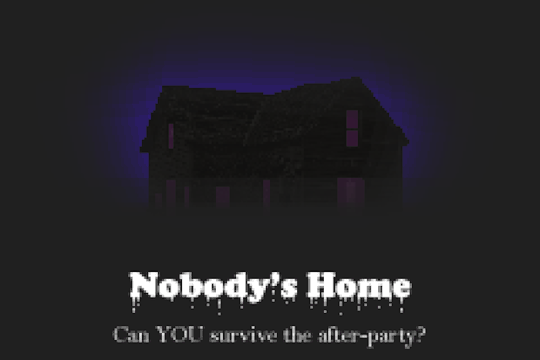
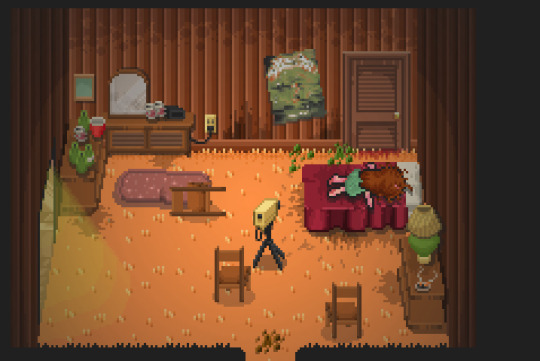
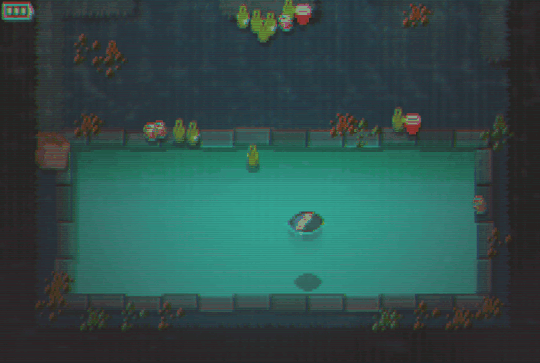

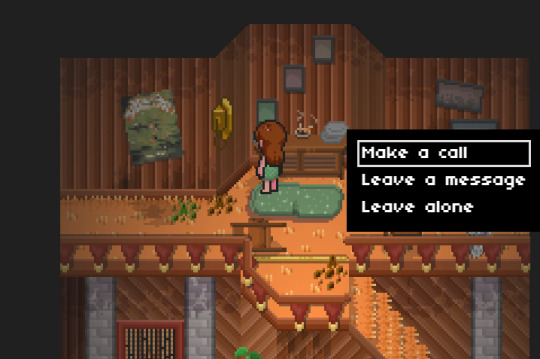
April’s Featured Game: Nobody's Home
DEVELOPER(S): oates ENGINE: RPG Maker MV GENRE: Survival Horror SUMMARY: After a night of extreme drinking and partying, you wake up in stranger's bed to discover... Nobody's Home.
Buy the game here! Our Interview With The Dev Team Below The Cut!
Introduce yourself! *oates: Hi, this is oates! I'm a pixel artist and game developer, I've started making games with rpgmaker in 2016 with VX Ace and now currently using MV for recent projects. Previous projects I've worked on were the FNaF-inspired Souls-like One Night at the Steeze, my first rpgmaker game and it's prequel, the FNaF-inspired roguelike No Delivery. Other games I've worked on include the fangames Day Dreaming Derpy, made in VX Ace and Spike's Day Off, made in MV and the latest in a series of previous fangames previously developed on Adobe Flash.
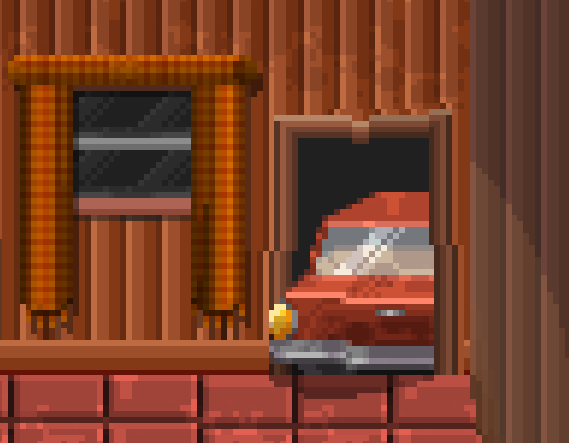
What is your project about? What inspired you to create this game initially? *oates: Nobody's Home is largely based on my experiments to find and apply horrific elements in modern situations or phenomena. The scenario being explored here in Nobody's Home is the aftermath of some crazy party. Sound design is especially important when crafting a horror scenario, so I often look to music to draw inspiration. Much of the atmosphere and house design was inspired by music and imagery associated with '70s yacht rock (a sub-genre of soft rock). Another important note is a lot of the general mood and 'weirdness' was inspired by a band I listen a lot to, Dance Gavin Dance, specifically their "deathstar" album. However they have a tendency in all their albums to switch genres mid-song, often going from their post-hardcore sound to funk, pop, and even rap; aside from that, some of the subject matter covered can range from disturbing to unpleasant to nonsensical, but combined with the amazing music, it creates an experience that pulls the listener in all different directions. It got to the point that I was naming events in the game after some their tracks so I had to be careful not to inadvertently make a fangame haha But there are some easter eggs in Nobody's Home that were intentionally left in, and I'm fairly certain players have identified it already.
How long did you work on your project? *oates: I used much of the same framework left over from my previous project No Delivery for this development cycle, so the hassle for setting up asset pipelines was very much mitigated. I started in earnest, making assets back in January this year so it took roughly 2+ months to finish development for this project.
Did any other games or media influence aspects of your project? *oates: Aside from the previous music inspirations, I was really intrigued with the way Resident Evil 7's Beginning Hour demo was able to pick up where Konami's cancelled PT left off in terms of survival horror games to look forward to back in 2017. Prior to later updates, the initial demo really only included a few set pieces, basic item interaction, and almost no puzzles from the full game. It was largely able to pull off scaring players from almost atmosphere alone (if you exclude the Jack Baker and ghost encounters). It was later in the full game that it was able to show off it's metroidvania-esque design to its fullest. After my previous project, I wanted to step away from roguelike design for a bit and focus a little more on an exploration-based experience, so I took a few notes from the way RE7 and RE2: Remake handled map design and progression.
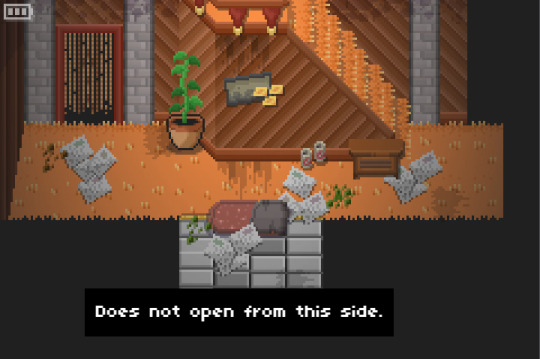
Did you come across any challenges during development? How did you overcome or work around them? *oates: I was coming off a severe cold last year and it took most of January for me to recover, so it was a little hard to start full-on development immediately like I normally would on top of other career matters. And looking at events today, it's even more imperative that developers practice healthy habits during development.
Did any aspects of your project change over time? How does your current project differ from your initial concept? *oates: I've had the idea for Nobody's Home as a concept for a while, but filling in those gaps with actual gameplay between centerpieces was a big variable. I went back and forth between the turn-based item combat from the previous project to cutting out combat entirely. While I didn't implement it, I also brainstormed a few concepts for overworld action and combat ala Zelda, but it seemed too complex given the time frame I set for myself. Eventually I settled on a middle ground between full combat and separate encounters, with "enemies" acting as essentially a toll gate. The rest of the game followed suit with various tolls and "mouse traps" for the player to trigger at their own behest. This wasn't necessarily the design I had in mind at first, but it helped to concisely fill a relatively small location with specifically "deadly" content.
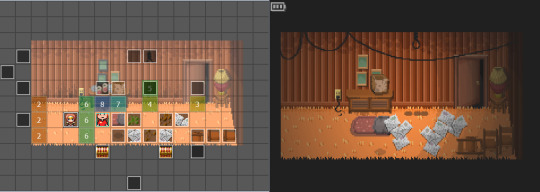
What was your team like at the beginning? How did people join the team? If you don’t have a team, do you wish you had one or do you prefer working alone? *oates: I largely work solo for both development and art, but I do regularly work with a few musicians for an original soundtrack. I first started working with other composers for the fangame Day Dreaming Derpy, where after the initial demo was released, I received emails from a few musicians volunteering to contribute some tracks for the game. In all, the original soundtrack contained 9 tracks in total, with 3 tracks from each composer; each of them doing an amazing job and, in my opinion brought the project back then to a higher degree of quality. This was how I met some of the composers I still work with today and they all have some really great work! TheNGVirus @NGVirusNG1 Kaminakat @thekaminakat dRedder @HornyGremlin
What is the best part of developing a game? *oates: It's a toss up between the initial brainstorming/research and the first run-through when you have your desired maps linked together. For the brainstorming, it's pretty fun to learn about subject matter you want to do justice to as well as stretching your creative muscles for the first time in service to a certain concept. However this obviously wears off when you devote too much time to a particular concept, but it's still enjoyable nevertheless. For making that run-through, it doesn't necessarily mean to have all the events implemented, but to experience your game the way players will experience it for the first time does give a sense of completion/cohesion to what you, as a developer, are trying to accomplish. It essentially puts what you're working on into a different perspective for you.
Do you find yourself playing other RPG Maker games to see what you can do with the engine, or do you prefer to do your own thing? *oates: I do keep an eye out for what other rpgmaker projects are doing, and to see what others can do with the engine helps get the creative juices flowing; it's also fun to try to mentally reverse engineer how certain mechanics or effects were made. And it's always great to see fellow devs showcase what's possible with the engine.
Which character in your game do you relate to the most and why? (Alternatively: Who is your favorite character and why?) *oates: Nobody's Home has a relatively small cast of characters, whom you do interact with but never see, this is largely to done to create a sense of "un-relatability", but if I had to pick a character, it'd be "car guy", the guy you find stuck in the car. They have a good line, " ...there'd be a good reason for this, but there isn't..." Story of my life.
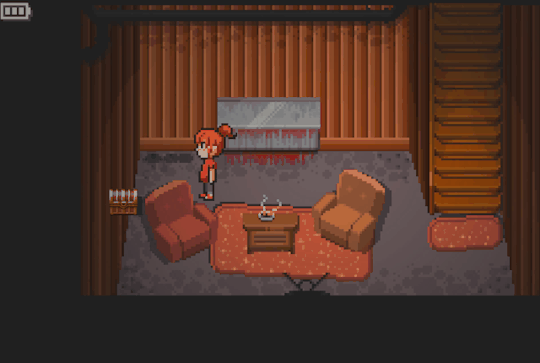
Looking back now, is there anything that regret/wish you had done differently? *oates: There were a few areas I would have liked to expand on or add, specifically- the attic + roof, the front lawn, behind the walls, and an entire second floor. Unfortunately that meant potentially adding more questlines and NPCs while the first set of questlines were pretty interwoven so it would have been way more complex, also again, given the time frame I set, it would have extended the development cycle way beyond what I had time for. But if I had implemented those extra areas, the game's length would also go way beyond the 30 min - 1 hr it takes to complete the game as it is now.
Do you plan to explore the game’s universe and characters further in subsequent projects, or leave it as-is? *oates: I'd like to do both really, each installment of the VCRPG line of games is definitely a stand-alone story, or an isolated incident, but I would love to explore the aftermath of the game's events and how the passage of time ravages and twists the story into urban legend. I like to treat places and environments like characters as well, capable of making memories, being misunderstood, preserved, destroyed, and ultimately capable of change.
What do you most look forward to upon finishing the game? *oates: Both the fan reaction and free time honestly speaking. Once the development cycle finishes and the game is published, your work isn't really finished as there's always a chance someone's feedback can apply to immediate changes or patches you can implement, even during the release period. Marketing is also another large step to take into consideration after release, this includes tweeting, sending keys for lets plays, etc. Watching playthroughs is also a really good way to collect data on what parts of your design fall through and what fail to land. But after all that is said and done, some free time really helps the brain recuperate.
Was there something you were afraid of concerning the development or the release of your game? *oates: Just whether or not I handled the game's subject matter tastefully. Like horror cinema, everything done is in service the the themes and message of the piece as a whole.
Do you have any advice for upcoming devs? *oates: The game engine is essentially a tool, and like any tool you can find plenty of creative ways to get the same result. And don't be afraid to research whatever it is you need help with, it also helps to be specific with what you want.
Question from last month's featured dev @moca-pz: If you can collaborate with any game developer in the world, who would it be? What would be their role(s) and what would be your role(s)? *oates: Game developer I'd like to work with: Hidetaka Miyazaki His role: Story Lead and Director My role: Drinking buddy Game we're working on: SciFi Souls
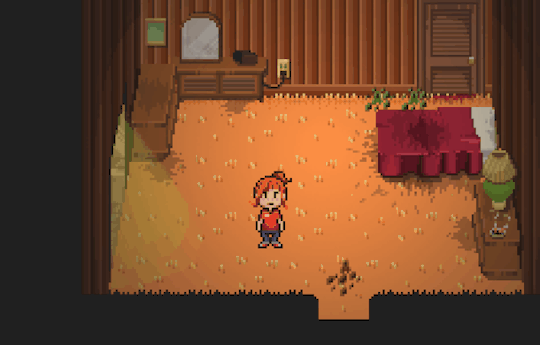
We mods would like to thank oates for agreeing to our interview! We believe that featuring the developer and their creative process is just as important as featuring the final product. Hopefully this Q&A segment has been an entertaining and insightful experience for everyone involved!
Remember to check out Nobody's Home if you haven’t already! See you next month!
- Mods Gold & Platinum
#rpg maker#nobody's home (game)#nobodys home#nobody's home#game#rpgmaker horror#pixel horror#horror game#indie game#gotm#game of the month#oates#gotm 2020#2020#april#april 2020
325 notes
·
View notes
Photo

‘RESIDENT EVIL 3′ - REVIEW ROUNDUP!
The latest remastered instalment in this truly iconic horror gaming franchise has returned in terrifying style. Those hardcore Resi fans will have been queuing around the block for this one to drop! However we know there’ll be some of you who’ve waited for the big names to have their say before returning to Raccoon City.
It’s a good thing we have you covered. Below we’ve compiled the best of the reputable reviewers for your reading pleasure! Be seeing you soon, Jill...
GameRevolution - 4/5
“I thoroughly enjoyed escaping from Raccoon City again, and I loved the expanded story. Resident Evil 3 remake is a great game that is held back from being truly excellent by a few factors. However, series fans will love seeing Jill and Carlos in a new light, and it’s practically a must-play for anyone who loved RE2 remake.”
Read the full review here.
Destructoid - 8/10
“The remake of Resident Evil 3 is going to be divisive, just as the original was. While the action enhancements help the game mechanically (to the point where I wouldn't mind seeing them in other remakes), the stripped-down focus and removal of some of the original's weirder experiments hurt it. That all said, I'm still up for a yearly playthrough of both the original and the remake.”
Read the full review here.
GamesRadar - 4/5
“The single player however is decent enough that the multiplayer is just a bonus. That said the main campaign does feel brief and light - I clocked a 9 hour completion time that included plenty of backtracking to find the few upgrades and extras scattered around. As I mentioned, there’s fewer puzzles, or multistage lock systems to unreveal, favouring instead a more direct progression of door opening. It lacks the breadth of the last remake in that sense but with the focus more on action it suits a faster pace and the balance still creates satisfying, albeit lighter, reimagining for the series.”
Read the full review here.
VideoGamer - 8/10
“Bravery only takes shape when there are graspable stakes, and atomic bombs blow everything out of proportion. Resident Evil 3 isn’t about humans, it’s about heroes. If I could pair it with another game, for a draining double-feature, it would be The Last Of Us. Think of the atmosphere in Naughty Dog’s game: guilt-stained and sombre, its characters bent under unbearable weight. To which Capcom provides the perfect ironic tonic: when the world will end in flames, we need a supercop.”
Read the full review here.
IGN - 9/10
“Overall, Resident Evil 3 is a wonderful continuation of Capcom’s latest remake efforts. Although its just-okay multiplayer mode falls short of the bar set by its magnificent single-player campaign, the latter does such a good job at balancing 2020 gameplay and a classic Resident Evil tone that I recommend it without reservations. Hopefully, we’ll see more classic games in Capcom’s library remade with such finesse and loving care – along with some new games, too.”
Read the full review here.
GodIsAGeek - 9/10
“Resident Evil 3 is fantastic. Nemesis never becomes frustrating, and that dread in the back of your mind never goes away as you’re always waiting for him to pop up again. It looks amazing, with every location packed with great definition and detail. Whilst it may only take around seven hours to complete (the original was similar), there’s still plenty of reasons to replay. The game is filled with collectables that open up models and concept art you can check out in the main menu, and the shop lets you purchase weapons, outfits, and more to take with you the next time you play.”
Read the full review here.
All in all, we’re looking at another nostalgic hit with modern day slick! It’s time to make your move and grab ‘Resident Evil 3′ from us here at The Game Collection!
-Jack
#resident evil 3#capcom#review roundup#review scores#ign#videogamer#godisageek#gamerevolution#destructoid#GamesRadar#gaming news#video game blog#new releases#Jill Valentine#thegamecollection#resi 3
0 notes
Text
Baba O'RileyFrom Wikipedia, the free encyclopedia
"Teenage Wasteland" redirects here. For the films, see
Teenage Wasteland (film)
or
Sleepaway Camp III: Teenage Wasteland
."Baba O'Riley"
Single
by
The Who
from the album
Who's Next
B-side
"
My Wife
"
Released23 October 1971
[1]
Format
7-inch single
Recorded
May 1971,
Olympic Studios, London, England[2]
Genre
Hard rock
[3]
Length5:08
Label
Polydor
Songwriter(s)
Pete Townshend
Producer(s)
The Who
Associate producer:
Glyn Johns
Executive producers:
Kit Lambert
Chris Stamp
Pete Kameron
The Who
singles chronology
"
Let's See Action
"
(1971)"
Baba O'Riley
"
(1971)"
Behind Blue Eyes
"
(1971)
Who's Next
track listing
9 tracks
[show]
"Baba O'Riley" is a song by the English rock band The Who. It is the opening track to the band's studio album Who's Next, and was issued in Europe as a single on 23 October 1971, coupled with "My Wife".
Roger Daltrey sings most of the song, with Pete Townshend singing the middle eight: "Don't cry/don't raise your eye/it's only teenage wasteland". The song's title is a combination of the names of two of Townshend's philosophical and musical influences, Meher Baba and Terry Riley.
"Baba O'Riley" was included in Time magazine's list of the All-Time 100 Songs, Rolling Stone's list of "The 500 Greatest Songs of All Time", and the Rock and Roll Hall of Fame as one of the 500 Songs That Shaped Rock and Roll.
Contents
[
hide
]
1Background and composition
2Recording and release
3Reception and legacy
4Personnel
5Charts
6References
7External links
Background and composition[edit]
Townshend originally wrote "Baba O'Riley" for his Lifehouse project, a rock opera that was to be the follow-up to the Who's 1969 opera, Tommy. In Lifehouse, the song would be sung at the beginning by a Scottish farmer named Ray, as he gathers his wife Sally and his two children to begin their exodus to London. When Lifehouse was scrapped, eight of the songs were salvaged and recorded for The Who's 1971 album Who's Next, with "Baba O'Riley" as the lead-off track.
Townshend stated in an interview that "'Baba O'Riley' is about the absolute desolation of teenagers at Woodstock, where audience members were strung out on acid and 20 people had brain damage. The irony was that some listeners took the song to be a teenage celebration: 'Teenage Wasteland, yes! We're all wasted!'"[4]
The "Baba O'Riley" title combines the names of Meher Baba and Terry Riley, two of Townshend's philosophical and musical mentors.[5] The song is often mistakenly called "Teenage Wasteland", after the phrase repeated in the song. "Teenage Wasteland" was in fact a working title for the song in its early incarnations as part of the Lifehouse project, but eventually became the title for a different but related song by Townshend, which is slower and features different lyrics.[6] A demo of "Teenage Wasteland" is featured on Lifehouse Chronicles, a six disc set of music related to the Lifehouse project, and on several Townshend compilations and videos.
The song uses a I-V-IV chord progression and is composed in the key of F major. However, it was recorded using the European "A" which is 446 HZ rather than the standard 440 HZ.[7]
Recording and release[edit]
"Baba O'Riley"'s backing track was derived from the Lifehouse concept, where Townshend wanted to input the vital signs and personality of Meher Baba into a synthesiser, which would then generate music based on that data. When this idea fell through, Townshend instead recorded a Lowrey Berkshire Deluxe TBO-1 organ using its marimba repeat feature as the backing track.[8] This modal approach was inspired by the work of minimalist composer Terry Riley.
The song was derived from a nine-minute demo, which the band reconstructed.[9] "Baba O'Riley" was initially 30 minutes in length, but was edited down to the "high points" of the track for Who's Next.[10] The other parts of the song appeared on the third disc of Townshend's Lifehouse Chronicles as "Baba M1 (O'Riley 1st Movement 1971)" and "Baba M2 (2nd Movement Part 1 1971)".
"Baba O'Riley" was released in November 1971 as a single in several European countries. However, in the United Kingdom and the United States, it was only released as part of the album Who's Next.
Reception and legacy[edit]
The Who
performing Baba O'Riley live at Manchester Arena in 2014.
"Baba O'Riley" appears at No. 349 on Rolling Stone's list of "The 500 Greatest Songs of All Time".[11] The song is in the Rock and Roll Hall of Fame as one of the 500 Songs That Shaped Rock and Roll.[12] The band Pearl Jam regularly plays a cover of the song during concerts, and a readers' poll in Rolling Stone awarded this cover as #8 in their Greatest Live Cover Songs.[13]
The Tubes performed the song on 9 September 1978 at the Knebworth Festival in tribute to Keith Moon, who had died two days earlier.[14]
"Baba O'Riley" was used as the theme song for the popular television series CSI: NY (2004–13); each CSI series used a Who song as its theme.[15] The song plays in the opening segment of the Miami Vice episode "Out Where the Buses Don't Run" (season two, 1985).[16] One of the working titles of That '70s Show (1998–2006) was "Teenage Wasteland," a reference to the repeated lyric in the song.[17] The song was also used in trailers for A Bug's Life (1998), American Beauty (1999), Resident Evil: Retribution (2012), and The Peanuts Movie (2015).[18] The song has also been used in episode 14 of season one in the TV series House and in episode 10 of season one in the TV series The Newsroom. A remixed version of this song, re-done by Alan Wilkis, appears in the 2012 remake of Need for Speed: Most Wanted, as well as the Family Guy season 13 episode "Quagmire's Mom" and episode 11 of season one of Superstore.
Since 2003, "Baba O'Riley" is played during player introductions for the Los Angeles Lakers during home games at the Staples Center.[19] The song is played prior to live UFC events during a highlight package showing some of the most famous fights in the mixed martial arts company's history.[20] It is also the official theme song of competitive eater Joey Chestnut.[21]
At both the opening and closing ceremonies of the 2012 London Olympics, the track "The Road Goes On Forever" by High Contrast is used during a countdown to the start of the proceedings, this song samples Baba O'Riley with a higher tempo as a 120bpm dance track.[22] Baba O'Riley was then performed by the Who as their first number during the last musical segment at the closing ceremony, with Daltrey singing a changed lyric of "Don't cry/Just raise your eye/There's more than teenage wasteland".[23] The song was also sampled in the song "Best Song Ever" by One Direction. Baba O' Riley is also used as the pregame music at Sanford Stadium and is played approximately 7 minutes before every Georgia home football game.
Personnel[edit]
Roger Daltrey – lead vocals, harmonica (live versions only)
Pete Townshend – lead vocals (middle eight), Lowrey TBO-1 organ,[24] piano, guitar
John Entwistle – bass guitar
Keith Moon – drums
Dave Arbus – violin[25] (studio recording)
3 notes
·
View notes
Text
[section_title title=Classic PC Case Mods]
It is time to start showing off the cases that have entered the Modders Inc Case Mod Contest. As we get more entries in the contest we will add then, so make sure that you bookmark this page and check back often. What we will do is post them into the Division they have entered. This way you can judge what your competition is. I think EVERYONE should enter as it looks like we will be having a few “Custom Entry Prizes” to give away!
Classic PC Case Mod: consists of any mod that is built from an existing retail PC Case. We do require at least 80% of the original case be used. If we deem that less than 80% of the original case was not used you will we moved to the Scratch-Build style.
My name James Nickell as this is my computer case mod. About My Case – I built a Resident Evil 2 Remake in the Corsair 570x. Resident Evil was one of my favorite games growing up so when RE2 Remake was announced I started planning a build around it so I could play it on PC. Specs Asus Z390 Gaming H, Intel 9700k, 32gigs Corsair memory, Asus Strix 1080ti.
[section_title title=Scratch Build PC Case Mods]
Scratch-Build PC Case Mod: consists of any mod built from anything else than a retail PC Case.
Mayhem Modz says Hello everyone this was my first scratch mod. it took a lot of work about 1 year, I started from a black hawk concept it seemed more appropriate, my construction elements were aluminum strips, steel sheets, some recycled parts of other houses, and a lot of plexiglass, I am proud to have made this work of art, all done love without the use of CNC or laser, all school Vecchia, I wanted to show that even if you do not have a CNC or cutting laser if you have a passion you can make a good pc case mod.
My name is Björn Höjing Burle (BHB-Mods/Deriveh). I’m a Swedish modder and I’ll be presenting my first custom-loop and my first scratch-build computer. This is my third modded computer since I got into modding as late as 2017. I got the idea to my build when I got home from Dreamhack Winter 2018 in Sweden, my wife wanted an iMac and I had just finished a modding project and look at all the great custom-loops on Dreamhack. Thus the idea to the iPreadator Powder was born. I decided I wanted to do a badass gaming PC, custom cooled on the backside of a 34″ monitor in an open industrial style case/frame.
I spent just over a year completing this build. When I began I basically just had the hardware from my old computer. I didn’t even have a 34″ monitor. My budget was quite strained as well so I some of the time it took went into looking for used parts, thus most of the parts of my build is used and not newly bought. The first part I got was the monitor, I had to do some research of which stands might be able to hold the weight of 25kgs as well as look alright to the industrial look I wanted, thus I chose the Acer X34.
The main plate of which all the components are placed in a 5mm thick aluminum plate at the exact same specifications as my Acer X34P monitor. I had to bring in help from a friend with an engineering company to manage to bend the plate at a 6-degree angle because of the thickness of the plate, I could not do it myself. I then used a jigsaw, hand files, sandpaper, polish, and other handheld tools to get all the shapes and finish done. I also painted the monitor white, ground down the pain of the monitor stand, and brushed it.
David Engelhardt & Tony Hall have this to say about the case mod they entered. The case inspiration came from the name of the PC Shop I work at, Blue Candle Computers, and the fact that we could not find where anyone had done a Candle computer. The outside is a plastic shell with a spray foam top. The top was shaped and covered with liquid rubber. Then the whole thing was covered with 7 pounds of wax. We did have it QuakeCon 2019,as it was my BYOC PC, but we didn’t think about entering the MOD contest. All of that is mounted inside on a custom Plywood Base.
For the last year, I have kept it on display at my shop and even use it to run a monitor on the front counter as an example of a Custom Computer. For BYOC 2019, the computer was always running, unless we were sleeping. The wax did not melt. In the last year, the wax shell that holds the flame up has bonded with the wax below.
David Cathey, tell us about your Scratch Built Computer… About My Case: Leaf Me Alone is a scratch build case using walnut and aluminum and has a nature theme. The idea was for a case that was less ‘gamer’ and more furniture piece that could be placed on a table and shown off. Starting with the interior, the tray is aluminum with the motherboard and a vertical GPU bracket on one side and brackets for the PSU and drives on the other. It is finished with a sanded pattern to give it a more wispy, natural look to go match the theme and provide some more visual interest. The main focal point of the interior is the wiring. All the wiring has been sleeved in a green paracord with the 24 pin and GPU power cables going through the tray to create a leaf pattern. The exterior of the case is a clamshell design, with aluminum on one side finished with light green paint and the other side is solid 3/4″ walnut. A leaf motif (walnut leaves to match the wood) was carved into the walnut and then filled with epoxy containing a green metallic flake. To help get some air to the components, vents were cut into the walnut side panel in the shape of leaves to stick to the theme. The walnut is finished with tung oil and then a polyurethane to protect the wood. The exterior halves attach to the tray with aluminum extensions, the top is open to aid cooling, and then the tray sits on a walnut base, finished to match the walnut of the shell. The base includes the power and reset buttons, also made of walnut to blend into the base.
This case is designed to last like good furniture so no major modding was done to the hardware so upgrading in the future would be easy. The case supports ATX and mATX motherboards, standard 2 slot GPUs, a standard ATX PSU, and 3 2.5″ drives, though the GPU, PSU, and drives are on brackets that can be replaced if necessary. The one-piece of hardware modding was fitting the Cooler Master Geminii M4 cooler on to the chip. A new mounting bracket for AM4 had to be created since the Geminii M4 doesn’t support AM4. This was done by replacing a few parts of the cooler with custom aluminum brackets and using a Corsair backplate for mounting.
Dante Mutti is going to tell us about his High Voltage PC Case Mod
About 11 years before I started this mod, I saw a vintage Oscilloscope in a flea market and I immediately fell in love with the design. I purchased one soon after, with the intent to build a mod, and it sat in my garage for over a decade. Fast forward to 2018 and this project finally began to come to life.
The power supply is by far one of my favorite parts of this mod. I purchased an old residential power switch housing at an estate sale with the intent of using it as the power supply shroud for my mod. Inside, it will house an EVGA SFX 650W Power Supply. The holes were cut for the vent, power switch, and the fan intake. Rubber u-channel molding was used to make the edges look cleaner and more professional. I made Glow-In-The-Dark paint by mixing Matte Medium with Glow Pigment Powder. I then painted the inside of the main case with it, so that the UV lighting inside the case would charge up the glow particles in the paint, and when you turn off the lights or the PC, the inside of the case would remain glowing.
On the side of the case, I added a “Big Red Button” that serves as the Power Button for the PC. I also added 2 industrial On/Off switches that control the lighting. The left toggle switch turns on and off the white interior light of the power gauge. The right toggle switch turns on and off the UV lighting inside the case. The front of the Oscilloscope had a red light that turned on when you powered on the scope. I wanted to retain this functionality and have the Oscilloscope’s Power Light be the Computer’s Power Light as well, which I achieved by wiring an LED to this location from the motherboard’s power light header.
[section_title title=id/Bethesda Themed PC Case Mods]
id/Bethesda Themed PC Case Mod: consists of any mod style (classic or scratch) but must be themed about id Software/Bethesda or any of their games (old, current, or upcoming).
My name is Rob Wilson and my case is themed after the Khajiit, the race of cat-people in The Elder Scrolls Online. Its most noticeable feature is that it is covered in faux snow leopard fur. The front panel is 3D printed and includes fan grills made from the Khajiit emblem. The top panel is also 3D printed and includes a fan grill made from a Khajiit shield. Both panels are held on by magnets, which allow them to be easily removed for fan cleaning or other maintenance. The inside of the case is hand-painted and then hand glazed with iridescence to make it shimmer like a moonstone, the Khajiit crafting style material. The computer is cooled by a custom loop that is filled with a clear liquid similar in appearance to the moon sugar drinks often enjoyed by the Khajiit. The custom loop includes a magnetic 3D printed housing which allows the reservoir to mount horizontally, and permits easy installation or removal for maintaining the loop. All 3D printing is my own design and fabrication
QuakeCon at Home PC Case Mods It is time to start showing off the cases that have entered the Modders Inc Case Mod Contest.
1 note
·
View note
Text
Staff Picks: Our Favorite Video Games of 2019
Welcome to the second part of our annual “Staff Picks,” in which the Ani-Gamers team selects some of our favorite anime, manga, and video games of the past year. This time we’re talking video games!
As usual there are a lot of games to cover, and between our two contributors we weren’t able to play nearly as many of them as we’d like. This year saw two standout first-party Nintendo RPGs, including the first-ever original core-series Pokémon games on a home console, the long-awaited release of Hideo Kojima’s inscrutable Death Stranding, a new AAA Star Wars action game (Jedi: Fallen Order), and both Outer Worlds and Outer Wilds. Meanwhile, last year’s big story of game industry unionization has continued to make headlines, notably at the Game Developer’s Conference in the spring, where major industry figures publically expressed their support for unionization. And that’s not the only area where politics had a big impact on gaming in 2019 — Blizzard’s suspension of Blitzchung over his support for the Hong Kong protests highlighted the contradiction between the values held by game industry workers (including pro players) and their bosses. As uncomfortable as these conversations are, they’re vital for building a more ethical industry.
In terms of the games themselves, many of them didn’t make it out of our piles of shame in time for the Staff Picks, but the ones that made the cut cover a wide range of genres, including complex action games, extremely anime JRPGs, and obtuse puzzlers. Enjoy, and feel free to chime in with your own 2019 picks in the comments.
David Estrella
#3: Sekiro: Shadows Die Twice
The hardest part about Sekiro was mending my relationship with my podcast co-host after debating the ethical conundrum of difficult video games and being made to look like a prick on tape. I’m completely making up what happened so don’t ban me from the site, Evan. Levity aside, the irony is that I never actually finished Sekiro and gave up at an endgame optional boss. A far departure from both Dark Souls and Bloodborne, From Software’s katana-focused revenge story did a Shinobi Execution to my hundreds of hours of experience and I was forced to learn everything over again. Some people really got on board with the action-focused gameplay whereas I flunked out of samurai school, so Sekiro is only the third-best pick from me on my list. If there had been more lore to pick up off the ground, I probably would have finished it, but I think everyone’s favorite fantasy author, George R.R. Martin, has me covered with Elden Ring, which will definitely be closer to what I expect from Hidetaka Miyazaki than what I got from Sekiro.
#2: Resident Evil 2
I originally wrote in Fire Emblem: Three Houses in here but I never finished that game in 2019. Resident Evil 2 (2019) on the other hand is a game I beat again and again throughout the year when I should have been focusing on other games (like Fire Emblem). First released on PlayStation over 20 years ago, the RE2 remake takes every great bit from that classic and reimagines it in the new engine used for Resident Evil 7. Fighting to survive Raccoon City’s zombie apocalypse again with Leon S. Kennedy and Claire Redfield in a game rebuilt for modern standards is not something I expected to see, but I suppose Capcom didn’t want to be shown up by Square Enix reviving the 32-bit era with the upcoming episodic Final Fantasy VII remakes. Conveniently enough, now that I’ve played RE2 inside out, we’re already getting the Resident Evil 3 remake in April, so now I’ve got one more good reason to put off finishing a single run of Fire Emblem in my lifetime.
#1: Pokémon Sword & Shield
No one should be surprised that I would call Pokémon Sword and Shield my top pick of the year. The only purpose for me doing this is to get it in writing but otherwise, yes, I really loved this iteration of the series. The reasons why I enjoyed it so much have practically nothing to do with the hyped-up gimmicks like Dynamax battles or the shift to console. On the one hand, things like story and environment design could have been much better, and on the other hand, I never want to go back to the old games after experiencing all of the quality-of-life changes made in Sword and Shield. Details that casual players won’t care about or ever become aware of like paying for max EVs with vitamins or using mints to change Natures have completely changed the game for anyone serious about raising Pokémon. If I were asked if these improvements were worth losing over 400 Pokémon from the roster, I would probably cry. Maybe. Maybe it was worth it.
Evan Minto
#3: Katana Zero
I played Superhot on a VR rig once, and it was the closest I ever felt to being a real-life action hero. In that game, “time moves when you do,” allowing you to plan out elaborate, perfectly executed lethal maneuvers in Matrix-esque bullet time. Katana Zero applies a similar concept to the 2-D action-platformer. You play as a samurai assassin in a dystopian cyberpunk future, equipped with a power that allows you to rewind time when you die and slow it down while in combat. The former is mostly experienced as a simple respawn mechanic, but the latter is what turns Katana Zero into a unique hybrid of a puzzle and action game. Each room is filled with bad guys who can one-hit kill you, sometimes so many that defeating them all would be impossible using standard action game timing. Slowing things down, however, turns the game into a sort of puzzle, and allows you to link up dashes, wall jumps, sword slashes, and projectile throws in the span of a second or two. When the game plays the room back in real time, you really do feel like some kind of superhero. It doesn’t hurt that the whole thing is wrapped up in an impeccable audiovisual package, featuring intricately animated pixel art, pulsing electronic music, and a clever dialogue display system that combines animated and colored text. The story is pretty standard stuff for the genre, but the surprisingly funny dialogue does a great job cutting the melodrama. It’s nothing groundbreaking, but Katana Zero is a clever, well-crafted little action game.
#2: Baba Is You
I tried Baba Is You for the first time at a friend’s place, and was instantly sold. After just a few levels, I told him, “this is a game for game designers.” The core mechanic is deceptively, deviously simple: the rules defining how the game world operates are blocks within the world, and you can rearrange them. The early levels are straightforward, if abstract, plays on this concept. Form the sentence “Flag is win” and you’ve got a win condition. Break up the sentence “Wall is stop” and voila: walls are no longer an obstacle. It’s when Baba Is You takes the core mechanic and folds it in on itself repeatedly, however, that this puzzler reaches the realm of obtuse, mind-bending complexity. You can change which sprite represents the player character, or even control multiple players at once. You can separate sprites into layers that prevent them from intersecting with each other. Even the words that form the sentences themselves can be modified! Baba Is You sometimes reaches nearly impossible levels of difficulty, but since you can choose the order in which to try the puzzles, the game will never stop you dead in your tracks. This kind of bizarre, postmodern weirdness is exactly what I come to indie games for.
#1: Fire Emblem: Three Houses
I never even finished the easiest half of Fire Emblem: Fates (Birthright), but I was glued to Awakening on the DS, my introduction to the franchise. In Three Houses Nintendo and Intelligent Systems aren’t even pretending that Fire Emblem is anything but a dating sim; you play as a part-time professor, part-time general, and the tactical RPG battles are interlaced with segments where you have to run around your home base talking to all of your students/units (fully voiced this time). At first this cumbersome back-and-forth, combined with a bevy of new combat mechanics, can make Three Houses feel like a game trapped between two conflicting identities, but after a few hours it clicked for me. All of the game’s seemingly mismatched systems, from the battalions to the tea parties, talk to and reinforce each other. Building relationships between your units boosts their stats and opens up opportunities to train them in new skills, all of which make them more effective in battle. Then their battle experience alongside their comrades feeds right back into their relationships. These mechanics have been around in some form since at least Awakening, but here they meld together like never before. Three Houses is a bewildering and sometimes overcomplicated successor to the Fire Emblem legacy, but the whole mess somehow comes together into a spellbinding experience.
Check out our 2019 Manga Staff Picks as well!
Staff Picks: Our Favorite Video Games of 2019 originally appeared on Ani-Gamers on January 8, 2020 at 4:58 PM.
By: David Estrella
0 notes